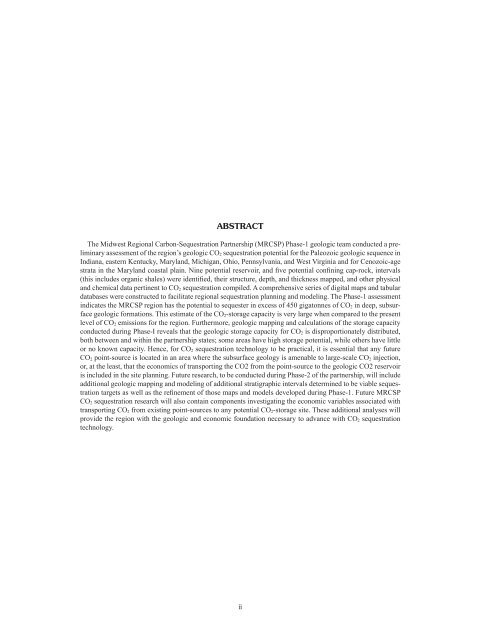MRCSP Phase I Geologic Characterization Report - Midwest ...
MRCSP Phase I Geologic Characterization Report - Midwest ...
MRCSP Phase I Geologic Characterization Report - Midwest ...
Create successful ePaper yourself
Turn your PDF publications into a flip-book with our unique Google optimized e-Paper software.
CHARACTERIZATION OF GEOLOGIC SEQUESTRATION OPPORTUNITIES IN THE <strong>MRCSP</strong> REGION<br />
ABSTRACT<br />
The <strong>Midwest</strong> Regional Carbon-Sequestration Partnership (<strong>MRCSP</strong>) <strong>Phase</strong>-1 geologic team conducted a preliminary<br />
assessment of the region’s geologic CO 2 sequestration potential for the Paleozoic geologic sequence in<br />
Indiana, eastern Kentucky, Maryland, Michigan, Ohio, Pennsylvania, and West Virginia and for Cenozoic-age<br />
strata in the Maryland coastal plain. Nine potential reservoir, and five potential confining cap-rock, intervals<br />
(this includes organic shales) were identified, their structure, depth, and thickness mapped, and other physical<br />
and chemical data pertinent to CO 2 sequestration compiled. A comprehensive series of digital maps and tabular<br />
databases were constructed to facilitate regional sequestration planning and modeling. The <strong>Phase</strong>-1 assessment<br />
indicates the <strong>MRCSP</strong> region has the potential to sequester in excess of 450 gigatonnes of CO 2 in deep, subsurface<br />
geologic formations. This estimate of the CO 2-storage capacity is very large when compared to the present<br />
level of CO 2 emissions for the region. Furthermore, geologic mapping and calculations of the storage capacity<br />
conducted during <strong>Phase</strong>-I reveals that the geologic storage capacity for CO 2 is disproportionately distributed,<br />
both between and within the partnership states; some areas have high storage potential, while others have little<br />
or no known capacity. Hence, for CO 2 sequestration technology to be practical, it is essential that any future<br />
CO 2 point-source is located in an area where the subsurface geology is amenable to large-scale CO 2 injection,<br />
or, at the least, that the economics of transporting the CO2 from the point-source to the geologic CO2 reservoir<br />
is included in the site planning. Future research, to be conducted during <strong>Phase</strong>-2 of the partnership, will include<br />
additional geologic mapping and modeling of additional stratigraphic intervals determined to be viable sequestration<br />
targets as well as the refinement of those maps and models developed during <strong>Phase</strong>-1. Future <strong>MRCSP</strong><br />
CO 2 sequestration research will also contain components investigating the economic variables associated with<br />
transporting CO 2 from existing point-sources to any potential CO 2-storage site. These additional analyses will<br />
provide the region with the geologic and economic foundation necessary to advance with CO 2 sequestration<br />
technology.<br />
ii





